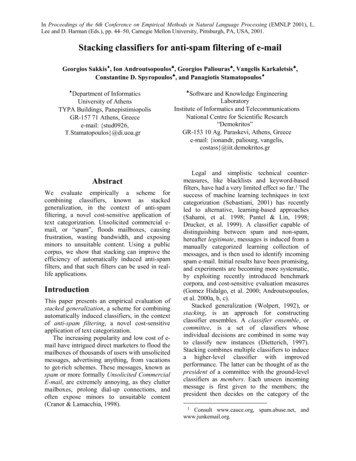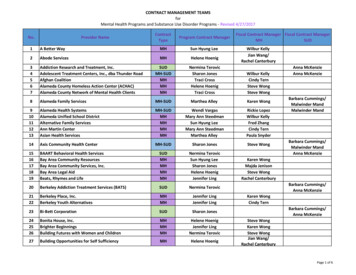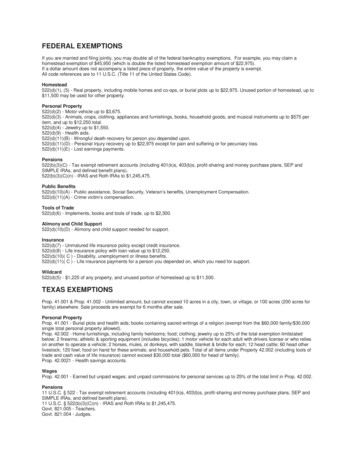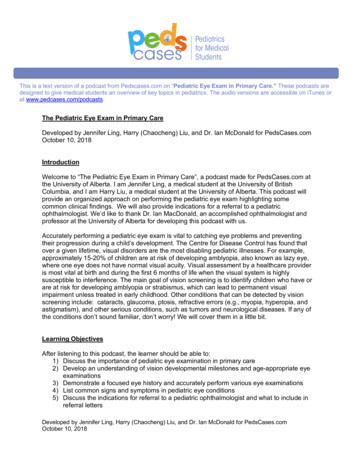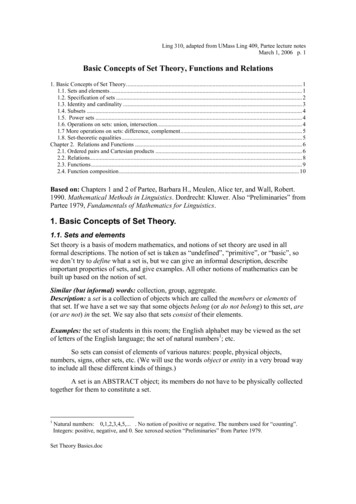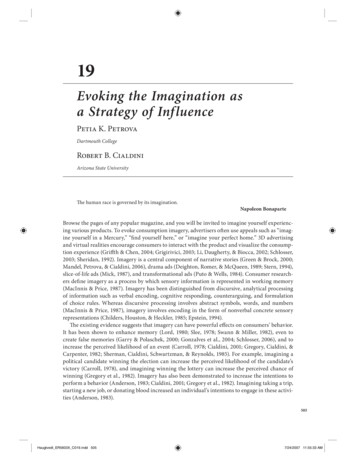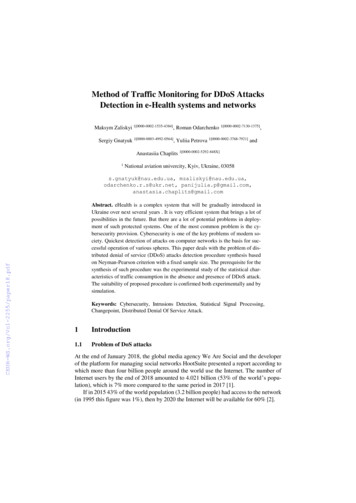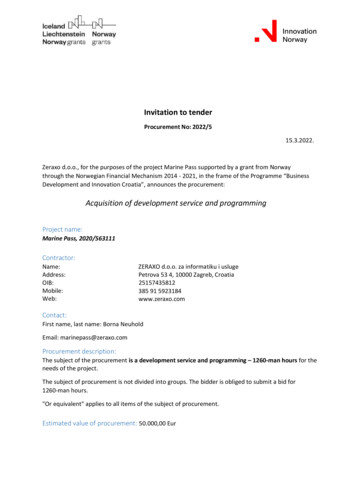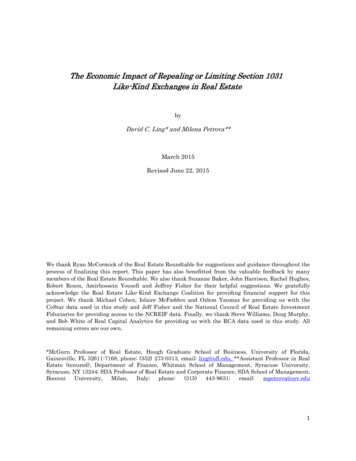
Transcription
The Economic Impact of Repealing or Limiting Section 1031Like-Kind Exchanges in Real EstatebyDavid C. Ling* and Milena Petrova**March 2015Revised June 22, 2015We thank Ryan McCormick of the Real Estate Roundtable for suggestions and guidance throughout theprocess of finalizing this report. This paper has also benefitted from the valuable feedback by manymembers of the Real Estate Roundtable. We also thank Suzanne Baker, John Harrison, Rachel Hughes,Robert Rozen, Amirhossein Yousefi and Jeffrey Fisher for their helpful suggestions. We gratefullyacknowledge the Real Estate Like-Kind Exchange Coalition for providing financial support for thisproject. We thank Michael Cohen, Iolaire McFadden and Ozlem Yanmaz for providing us with theCoStar data used in this study and Jeff Fisher and the National Council of Real Estate InvestmentFiduciaries for providing access to the NCREIF data. Finally, we thank Steve Williams, Doug Murphy,and Bob White of Real Capital Analytics for providing us with the RCA data used in this study. Allremaining errors are our own.*McGurn Professor of Real Estate, Hough Graduate School of Business, University of Florida,Gainesville, FL 32611-7168, phone: (352) 273-0313, email: ling@ufl.edu. **Assistant Professor in RealEstate (tenured), Department of Finance, Whitman School of Management, Syracuse University,Syracuse, NY 13244; SDA Professor of Real Estate and Corporate Finance, SDA School of 5)443-9631;email:mpetrova@syr.edu1
Table of ContentsExecutive Summary . 5Introduction and Summary of Results . 7Background on Tax-Deferred Exchanges . 10The Mechanics of Tax-Deferred Exchanges . 13Evidence on the Use of Real Estate Like-Kind Exchanges . 17Evidence from Transaction Databases . 17Evidence from IRS Data . 22Estimating the Magnitude of Exchange Tax Benefits. 23Model Assumptions . 25Deferral Benefits as a Percentage of Price . 27Exchange Benefits as a Percentage of Deferred Gains . 28Exchange Benefits as a Percentage of Deferred Tax Liabilities . 29Sensitivity to the Assumed Discount Rate . 30Residential versus Nonresidential Real Property . 31Estimated Loss in Treasury Revenue . 31Estimating the Effects of Elimination of Like-Kind Exchanges in Real Estate on PropertyValues and Rents . 33Model Assumptions . 35Estimated Nonresidential Price and Rent Effects of Elimination of Like-kind Exchanges . 37Estimated Nonresidential Price and Rent Effects of Elimination of Like-kind Exchanges inHigh-Tax Markets . 39Estimated Price and Rent Effects of Elimination of Like-kind Exchanges for ResidentialProperties . 41Economic Benefits of 1031 Exchanges – Empirical Evidence . 43Impact of Like-kind Exchanges on Investment. 43Impact of Like-kind Exchanges on Leverage . 45Impact of Like-kind Exchanges on Capital Expenditures . 47Impact of Like-kind Exchanges on Holding Periods . 48Like-kind Exchanges and Taxes . 50Macro-economic Consequences of the Established Micro-economic Effects . 52Conclusions . 54Appendix 1: Estimating the Net Present Value of Tax Deferral . 56Appendix 2: Predictive Model Used for Matching Like-kind Exchanges with Ordinary Sales. 622
References . 63Figures and Tables IndexFigure1: CoStar coverage for major property types . 65Figure 2: Incremental NPV of exchange as a percentage of property value . 66Figure 3: Incremental NPV of nonresidential exchange as a percentage of deferred gain 67Figure 4: Incremental NPV of exchange as a percentage of deferred taxes . 68Figure 5: Difference in incremental NPV as a percentage of deferred taxes . 69Figure 6: Incremental NPV of residential exchange as a percentage of deferred taxes . 70Figure 7-9: Internal rate of return and effective tax rates-nonresidential property . 71Figure 10: Required decrease in price after elimination of exchange-nonresidentialproperty. 72Figure 11: Required increase in rent after elimination of exchange-nonresidentialproperty. 72Figure 12: Required decrease in price after elimination of like-kind exchange-residentialproperty. 73Figure 13: Required increase in rent after elimination of like-kind exchange-residential 73Table 1: Distribution of CoStar exchanges and non-exchanges by year. . 74Table 2: Distribution of CoStar exchange and non-exchange sales by property type: 19972014 . 74Table 3: Percentage of CoStar sales by property type involved in like-kind exchange . 75Table 4: Distribution of CoStar exchange and non-exchange transactions by CBSA: 19972014 . 76Table 5: Percentage of all U.S. like-kind exchanges in each state-1997-2014 . 77Table 6: Percentage of CoStar sales by MSA involved in exchange-1997-2014 . 78Table 7: Real estate exchanges as a percentage of all CoStar sales in each state-1997-2014. 79Table 8: Estimated losses to Treasury from real estate like-kind exchanges (in billions) 80Table 9: Summary statistics for differences between relinquished and replacementproperty prices for like-kind exchanges vs. ordinary sales . 81Table 10: Summary statistics for differences between relinquished and replacementproperty prices for like-kind exchanges vs. ordinary sales expressed as percentage of valueof the relinquished property . 82Table 11: Summary statistics for percentage differences between replacement andrelinquished property prices for like-kind exchanges vs. ordinary sales by year . 833
Table 12: Summary statistics for differences between replacement and relinquishedproperty prices for like-kind exchanges vs. ordinary sales, expressed as a percentage ofthe relinquished property price, by year . 84Table 13: Summary statistics for differences between replacement and relinquishedproperty prices for like-kind exchanges vs. ordinary sales by state . 85Table 14: Summary statistics for initial leverage used by investors in like-kind exchangesvs. ordinary sales . 86Table 15: Summary statistics by year for initial leverage used by investors to acquirereplacement properties for exchanges and ordinary acquisitions . 87Table 16: Summary statistics by state for initial leverage used by investors in like-kindexchanges vs. ordinary acquisitions . 88Table 17: Summary statistics for capital expenditures for replacement properties inexchanges and ordinary acquisitions . 89Table 18: Summary statistics for holding periods of investors in like-kind exchanges vs.ordinary sales . 90Table 19: Summary statistics for holding periods in like-kind exchanges vs. ordinary salesby state. 91Table 20: Summary statistics for frequency of sale of 1031 exchange replacementproperties by year . 92Table 21: Summary statistics for capital and depreciation recapture tax liability over theholding period by sale strategy . 934
Executive SummaryWe examine the economic effects of repealing Section 1031 for real estate exchanges.After documenting the widespread use of real estate like-kind exchanges, we develop a modelthat quantifies the present value (cost) of an exchange to the owner (Treasury). We estimatethat the static present value of lost Treasury revenues from real estate exchanges ranged froma low of 200 million to a high of 3 billion in 2011, although these estimates overstate lostTreasury revenue because they assume taxpayers would have disposed of their properties infully-taxable sales in the absence of the option to exchange.We also develop a “typical project model” to estimate the range of short-run declines inprices that would be necessary to offset the increased tax burden of eliminating like-kindexchanges. In local markets where investors are moderately taxed, we estimate that prices ontypical office, industrial, retail and other commercial properties would have to decline eight to12 percent to maintain required investment returns. In the longer run, rents would need toincrease from eight to 13 percent to offset the effects of elimination. Price and rent effectswould be more pronounced in high-tax states.Our empirical analyses demonstrate that replacement like-kind exchanges areassociated with a higher investment of approximately 305,000 (33 percent of value) comparedto acquisitions by the same investor following the sale of their property. Properties used inlike-kind exchanges tend to be larger, newer and have lower vacancy rates. In addition, theuse of 1031 exchanges and investment in like-kind exchanges varies considerably with thereal estate market conditions. We also observe evidence that capital expenditures inreplacement exchange properties tend to be higher by about 0.27/sf- 0.40/sf.In addition to using some of the deferred gains to increase the size of their investmentin subsequent properties, investors in like-kind exchanges use less leverage than ordinaryinvestors to acquire replacement properties. Furthermore, holding periods for propertiesacquired through 1031 exchanges tend to be shorter. In summary, like-kind exchanges areassociated with increased investment, reduced leverage that reduces system-wide risk, andshorter holding periods.In contrast to the common view that replacement properties in an exchange arefrequently disposed of in a subsequent exchange to potentially avoid capital gain anddepreciation tax liability indefinitely, we find that in 88 percent of the cases in our datasetinvestors dispose of properties acquired in a 1031 exchange through a taxable sale. The5
estimated taxes paid when an exchange is followed by a taxable sale are on average 19 percenthigher than taxes paid when an ordinary sale is followed by an ordinary sale.Overall, our analysis suggests that the cost of like-kind exchanges is likely largelyoverestimated, while their benefits are overlooked. The elimination of real estate exchangeswill likely lead to a decrease in prices in the short-run, followed by an increase in rents in thelonger run. These negative effects will be more pronounced in high tax states. Elimination willalso likely produce a decrease in real estate investment, increase in investment holdingperiods, and an increase in the use of leverage.6
Introduction and Summary of ResultsAlthough Congress has frequently altered the taxation of accrued capital gains, Section1031 of the Internal Revenue Code has permitted taxpayers to defer the recognition of taxablegains on the disposition of business-use or investment assets since 1921. However, recent taxreform proposals from the chairman of Congressional tax-writing committees would eliminatethis deferral option on asset dispositions.The benefits that the option to exchange provides owner/operators in local commercialreal estate markets are numerous and significant. By deferring tax liabilities, exchanges canhelp preserve scarce investment capital. Investors can use this capital to acquire largerproperties, upgrade portfolios, and make capital improvements. In competitive rental markets,these benefits are shared with tenants in the form of improved space and reduced rents. Theequity preserved by an exchange may also lead to the use of lower leverage, thereby reducinginvestor (and system-wide) risk. Section 1031 exchanges can also be used to consolidate ordiversify properties or to substitute depreciable real property for non-depreciable realproperty. Tax-deferred exchanges also improve the marketability of highly illiquid commercialreal estate. This increased liquidity is especially important to the many non-institutionalinvestors in relatively inexpensive properties that typically dominate the market for realestate like-kind exchanges.From the perspective of the overall economy, allocative and macroeconomic effects favorcontinuation of real estate like-kind exchanges. The taxation of nominal capital gains atdisposition creates a potential “lock-in” effect in real estate and other asset markets. Ratherthan disposing of a suboptimal asset with a lower expected before-tax return and reinvestingthe proceeds in a more productive (higher return asset), investors with accrued capital gainsmay choose to continue to hold the less productive asset rather than realize the taxable gains.This suboptimal allocation of scarce investment capital exacts a cost on the economy as well ason the taxpayer. By eliminating potential lock-in effects, the option to exchange increases theability of investors to redeploy capital to other uses and/or geographic areas, upgrade andexpand the productivity of buildings and facilities, and otherwise engage in more income andjob creating spending. This has positive spillover effects in directly related industries such asconstruction, title insurance, and mortgage lending.We first document the widespread use of real estate like-kind exchanges and the extent towhich their use varies across states and metropolitan areas. California dominates other states7
in the use of exchanges. However, Colorado, Oregon, and Arizona, all states with relativelyhigh state income tax rates, also account for a disproportionate share of real estate like-kindexchanges.We next develop a “micro” model that quantifies the present value (cost) of an exchange tothe owner (Treasury). In addition to capturing the benefit of immediate tax deferral, thismodel incorporates the corresponding tax disadvantages of an exchange from the investor’sperspective; in particular, reduced depreciation deductions in the replacement property andincreased capital gain and depreciation recapture taxes at sale.The incremental value (cost to the Treasury) of a commercial property exchange as apercentage of the investor’s deferred tax liability ranges from 10 percent to 62 percent,depending on the holding period of the relinquished property, the amount of price appreciationexperienced by the relinquished property, and the amount of time the investor expects to holdthe replacement property before disposition in a fully taxable sale. The value of an exchangeas a percentage of deferred taxes for residential income producing property is similar.Assuming deferred gains from real estate account for 30 percent of the 70.8 billion totalreported by Treasury in 2011, we estimate that the static present value of lost tax revenuefrom 2011 real estate exchanges ranged from 0.2 billion to 1.4 billion. The 1.4 billionestimate is only four percent of total deferred gains reported by the Treasury in 2011.Moreover, the behavioral responses of investors to elimination of like-kind exchanges wouldpush estimates of increased Treasury revenue even lower.Although the present value of tax revenue losses associated with real estate like-kindexchanges is relatively small in magnitude, the elimination of exchanges would disrupt manylocal property markets and harm both tenants and owners. We use a “typical project model,”sometimes referred to as a “user cost of capital” model, to quantify the short-run declines inproperty prices that would be necessary to offset the increased tax burden on investors. Thetypical project model is also used to solve for the long-run increase in market rents that wouldbe required to offset the elimination of real estate like-kind exchanges.In local markets where moderately-taxed exchange motivated taxpayers are themarginal (price determining) investors, we estimate that prices on office, industrial, and retailproperties would have to decline eight to 12 percent to maintain required investment returnsfor investors expecting to use like-kind exchanges when disposing of properties. In the longerrun, real rents would need to increase from eight to 13 percent before construction would beviable. These higher rents would reduce the affordability of CRE space for both large and8
small tenants. Similar to our estimated price declines, rents would need to increase less inmarkets where the marginal buyer of commercial real estate places a low probability on usingan exchange to dispose of real estate.The price and rent effects of eliminating real estate like-kind exchanges would likely bemore pronounced in high-tax states, such as California, Colorado, Oregon, and Arizona. Inthese states, which also account for a disproportionate share of real estate like-kindexchanges, the typical investor is more likely to place a higher probability on using a like-kindexchange to dispose of an acquired property in subsequent years. We estimate that pricedeclines ranging from 23 to 27 percent would be required to offset the elimination ofexchanges in high-tax states, all else equal. In the longer run, we estimate rents would have toincrease 30 to 38 percent to restore equilibrium in local property markets. These representlarge potential short-run price and long-run rent changes in high-tax markets.In addition to conducting an analysis based on our “user cost of capital” model, weemploy data from Costar and NCREIF to examine the economic benefits of like-kindexchanges in real estate and some potential effects from the proposed removal of Section 1031exchanges. Our empirical analyses demonstrate that like-kind exchanges are associated withhigher investment, shorter holding periods and less leverage. More specifically, replacementlike-kind exchanges are associated with an investment in subsequent properties that is onaverage 305,000 (33 percent of value) greater than when a replacement property ispurchased following a fully taxable sale. This increased investment is robust over time and bystate, although it tends to be larger in strong markets and in states with higher tax rates.Capital expenditures (specifically building improvements) for replacement exchangeproperties tend to be higher by about 0.27/sf- 0.40/sf. This difference is 0.18/sf- 0.24/sf forbuilding improvements1.Furthermore, investors in like-kind exchanges tend to use less leverage to acquirereplacement properties than investors involved in ordinary acquisitions. More specifically,replacement properties involved in an exchange have median loan-to-value ratios of 63-64percent, while the median loan-to-value ratio for properties acquired in non-exchanges is 70percent. Holding periods for properties acquired through 1031 exchanges tend to be shorter.The average holding periods for exchanges vs. non exchanges are 3.5 and 4.0 years,1 The difference of capital expenditures in replacement properties vs. properties acquired in a taxable sale is notstatistically significant at conventional levels. The p-value of a one-tailed test is equal to 0.2, which implies that thehypothesis that the difference is larger than zero is rejected on average 20% of the time.9
respectively. Using a matched sample of exchange and non-exchange properties, we obtainsimilar results.Our results imply that the elimination of exchanges would lead to a decrease ininvestment, an increase in investment holding periods and possibly an increase in leverage.These micro effects are likely to have macroeconomic consequences as well. For example, areduction in real estate activity, resulting from lower investment and prices decreases, wouldlead to slower growth rate in employment, especially in the markets where like-kindexchanges are commonly used.When analyzing the potential cost of 1031 exchanges in real estate, we note that in 34percent of the cases in our dataset the replacement property is less expensive than therelinquished property, which implies that in approximately one-third of the cases some taxesare paid in the year the exchange is executed. Furthermore, we show that 88 percent of theinvestors in our sample that complete an exchange subsequently dispose of the replacementproperty in a fully taxable sale. That is, like-kind exchanges are not typically used topermanently exclude capital gain and depreciation recapture income from taxation; rather,they allow investors to temporality defer the recognition of such income. Moreover, thereduced depreciation deductions in the replacement property that accompany an exchangesignificantly offset the value of immediate tax deferral. Our analysis suggests that theestimated taxes paid in an exchange which is followed by a taxable sale are on average 19percent higher than when an ordinary sale is followed by an ordinary sale. These resultsreinforce our conclusion that the many “micro” and “macro” benefits of providing investorswith the flexibility to dispose of highly illiquid, capital intensive assets via an exchange exceedthe costs.Background on Tax-Deferred ExchangesAlthough Section 1031 of the Internal Revenue Code (IRC) dates back to the 1920’s,exchanges under the original restrictions could only be completed as a simultaneous swap ofproperties among two or more parties. The required simultaneity severely limited theusefulness of Section 1031 as a tax deferral tool due to the difficulty of synchronizing the closeof two or more complex transactions. In response to an earlier court decision related to the“Starker” case (Starker vs. United States, 602 F. 2d 1341 (9th Cir., 1979)), Congress amendedthe original regulations in 1984 to allow taxpayers more time to complete an exchange.Nevertheless, the Section 1031 exchange market did not fully evolve until 1991 when the10
Internal Revenue Service (IRS) issued final “safe harbor” regulations for initiating andcompleting delayed Section 1031 exchanges.A like-kind exchange is, strictly speaking, a tax deferral technique. The taxpayer’s basisin the replacement property is set equal to the transaction price of the replacement propertyminus the gain deferred on the disposition of the relinquished property. When thereplacement property is subsequently disposed of in a fully taxable sale, the realized gain willequal the deferred gain on the relinquished property plus any additional taxable gain accruedsince the acquisition of the replacement property.2 However, if the subsequent disposition ofthe replacement property is also structured in the form of a Section 1031 exchange, therealized gain on the first property can again be deferred, perhaps indefinitely.In order for the exchanging taxpayer to completely avoid the immediate recognition ofthe accrued taxable gain, he or she must acquire a property (or properties) of equal or greatervalue than the relinquished property. In addition, the taxpayer must use all of the net cashproceeds generated from the disposition of the relinquished property to purchase thereplacement property. The transaction is potentially taxable to the extent that (1) the value ofthe replacement property is less than the value of the relinquished property and (2) there iscash left over after the purchase of the replacement property.The ability to defer recognition of accrued capital gains, in whole or in part, whendisposing of an asset via a tax-deferred exchange confers a potential benefit to owners ofeligible assets (including commercial real estate) relative to assets that are not eligible forsuch deferred recognition of accrued gains. However, the appropriate tax treatment of capitalgains is not obvious.3 Some would argue that gains should be taxed fully at ordinary rates (noexclusion) as they accrue, not upon realization. Others would argue for favorable taxtreatment, although not necessarily for exclusion, because the deferral advantage of taxationupon realization might be a sufficient advantage, at least for longer holding periods. Stillothers would choose the taxation of real (not nominal) gains only, accompanied by thededuction of only real mortgage interest expense. Moreover, the optimal taxation of deferred2 In sharp contrast, since May 6, 1997 when the Taxpayer Relief Act of 1997 became law, if a single taxpayerowned and lived in her home as her principal residence for at least two of the five years prior to the sale, shepermanently exclude up to 250,000 of her capital gain from taxation. For married couples, filing jointly,exclusion is 500,000. This exclusion is potentially far more valuable to a home owner than the potentialdeferral available to owners of income-producing property under Section 1031.3hascanthetaxSee, for example, Follain, Hendershtt, and Ling (1987).11
capital gains would vary with the rate of inflation; in particular, higher rates of inflationshould be accompanied by lower rates of capital gain taxation, all else equal.Although Congress has frequently altered the taxation of accrued capital gains on mostasset classes, Section 1031 has permitted taxpayers to defer the recognition of taxable gainson the disposition of business-use or investment assets since 1921. From the perspective of theoverall economy, there are allocative and macroeconomic effects that favor continuation of realestate like-kind exchanges. It is well known that the taxation of nominal capital gains atdisposition creates a potential “lock-in” effect in real estate and other asset markets.4 Ratherthan selling a suboptimal asset with a lower expected before-tax return and reinvesting theproceeds in a more productive (higher expected return) asset, investors with accrued capitalgains may choose to continue holding the less productive asset to avoid realizing the taxablegains. This suboptimal allocation of scarce investment capital exacts a cost on the economy aswell as on the taxpayer.The macroeconomic issues that favor the continuation of like-kind exchanges are capitalformation and investment. Exchanges increase the ability of investors to redeploy capital toother uses and/or geographic areas, upgrade and expand the productivity of buildings andfacilities, and engage in more income and job creating spending. Section 1031 requiresinvestors to redeploy the capital from relinquished U.S. property within t
*McGurn Professor of Real Estate, Hough Graduate School of Business, University of Florida, Gainesville, FL 32611-7168, phone: (352) 273-0313, email: ling@ufl.edu. **Assistant Professor in Real Estate (tenured), Department of Finance, Whitman School of Management, Syracuse University,
